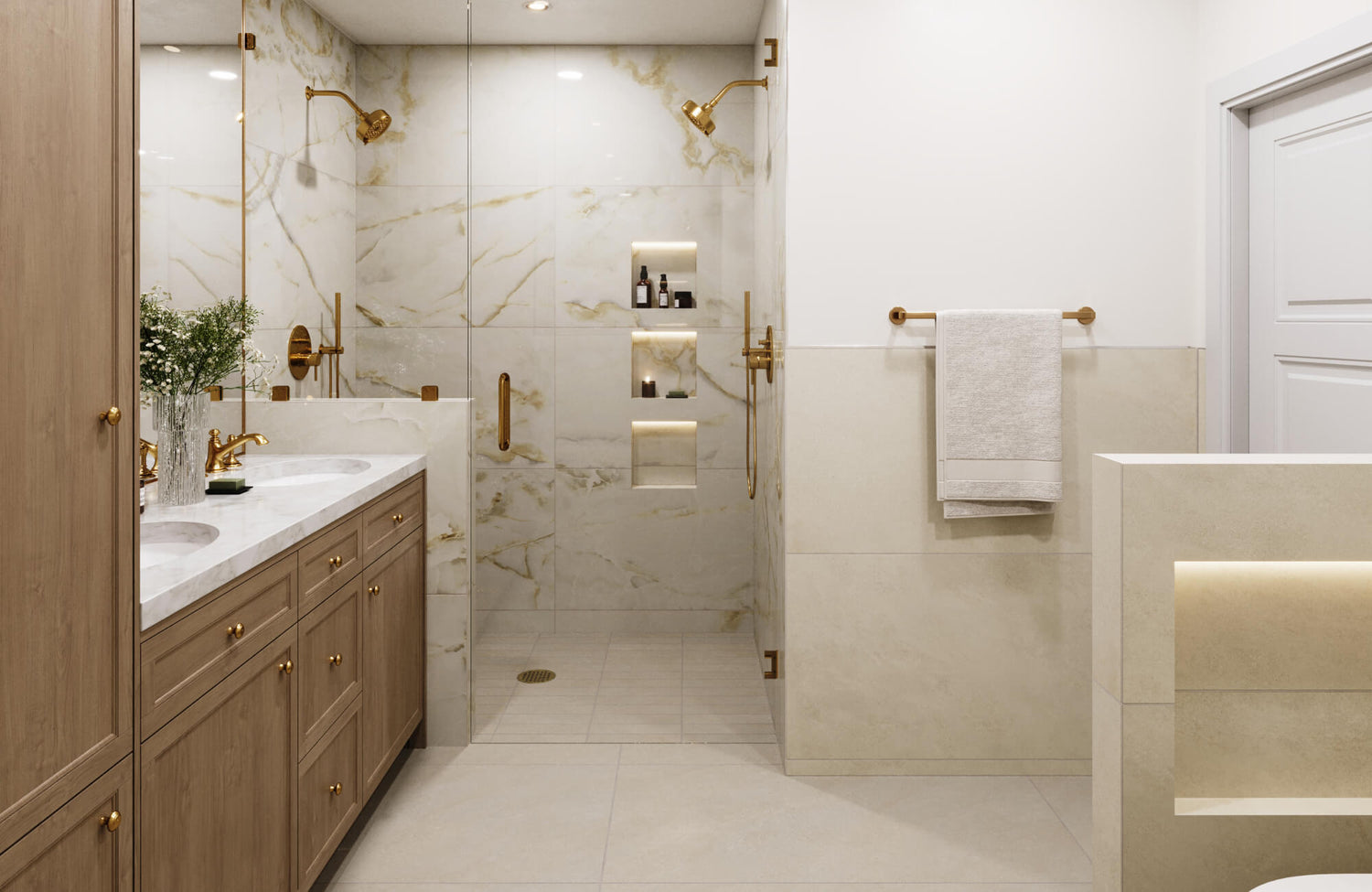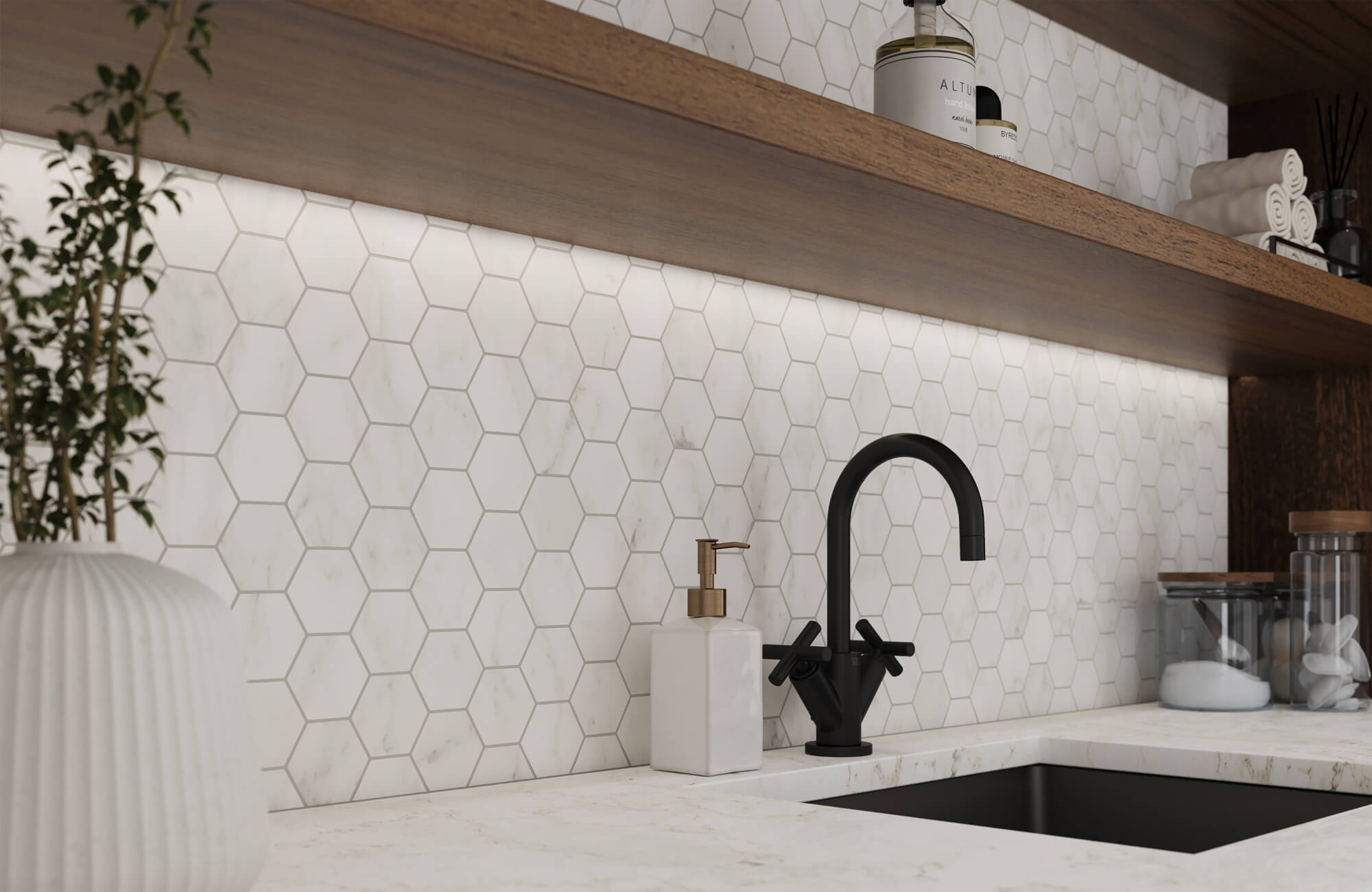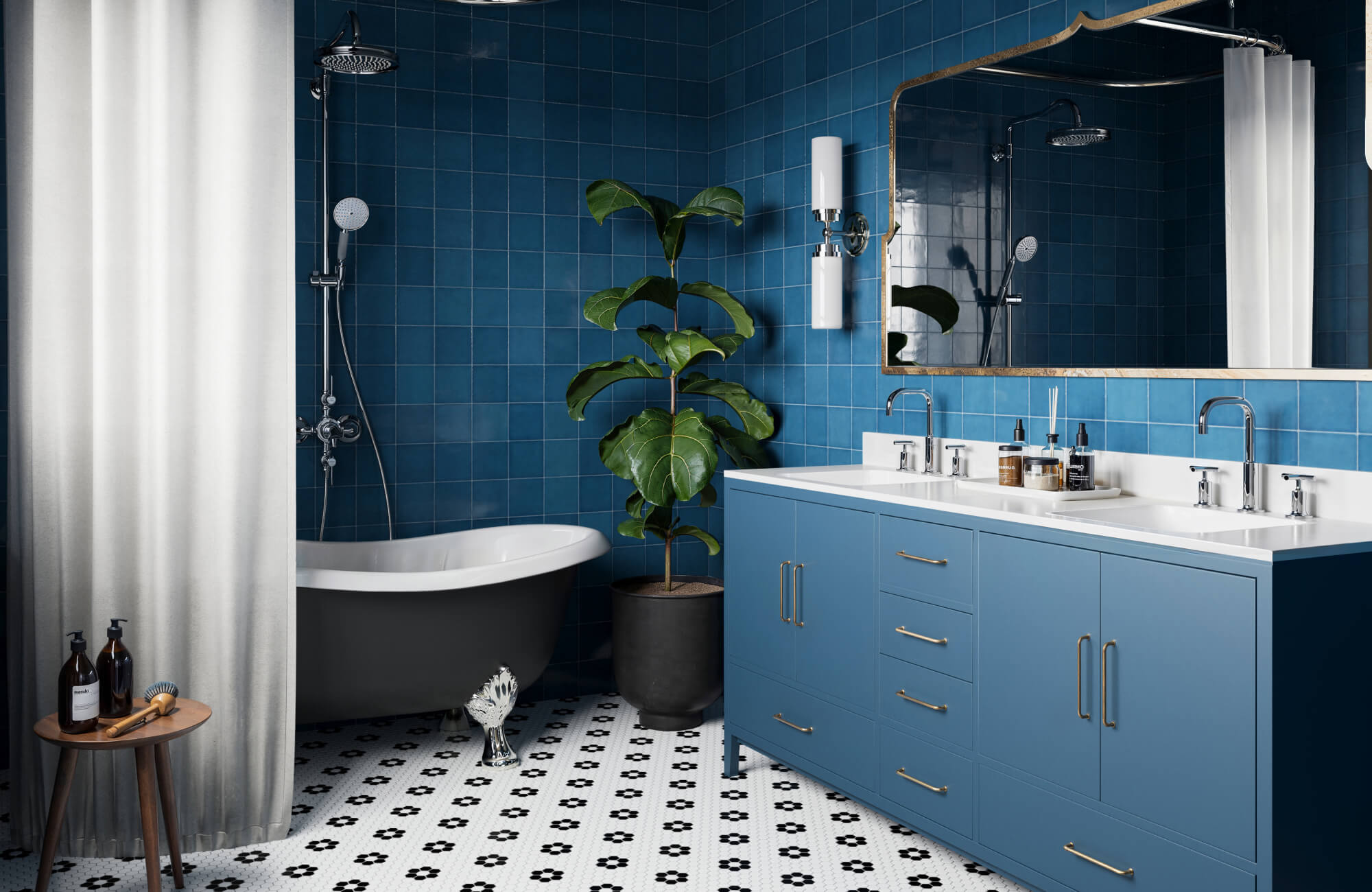Marble, a testament to nature's artistry, has long been revered for its elegance and durability. Its timeless appeal has made it a popular choice for elevating bathroom designs. However, when it comes to shower environments, a question often arises: "Can marble truly withstand the demands of moisture, temperature fluctuations, and daily use?"
In this comprehensive guide, we’ll dive into the world of marble in showers, exploring its captivating beauty, potential challenges, and practical tips for successful implementation. We'll also uncover the factors to consider when choosing marble for your shower, discuss the importance of proper installation and maintenance, and explore alternative materials that offer similar aesthetics and superior performance. By the end of this article, you'll be equipped with the knowledge to make an informed decision about whether marble is the right choice for your dream shower.

The Charm of Marble in Bathrooms
Marble, a metamorphic rock formed under immense pressure and heat, possesses an innate beauty that has captivated designers and homeowners for centuries. Its unique veining patterns, ranging from subtle to dramatic, add a touch of natural artistry to any space. Their versatility also allows it to seamlessly blend with various design styles, from classic to contemporary. Whether you prefer the cool, crisp tones of Carrara or the bold, dramatic veining of Calacatta, marble offers a wide range of options to suit individual preferences.
Beyond its aesthetic appeal, marble exudes a sense of luxury and opulence. Its smooth, polished surface reflects light, creating an elegant and sophisticated ambiance. The tactile experience of marble, with its cool, smooth touch, also adds a sensory dimension to a bathroom. The psychological impact of using such a luxurious material can enhance feelings of relaxation, tranquility, and well-being.

The Challenges of Marble in Shower Environments
Although beautiful, marble’s natural qualities can make it vulnerable in wet and humid conditions. Here are some of the downsides of marble in shower environments:
Porosity and Water Absorption
One of the primary challenges of using marble in shower environments is its inherent porosity. Marble, like many natural stones, has microscopic pores that can absorb water. While this characteristic contributes to its beauty, it also makes it susceptible to staining, particularly from water-based substances. When water penetrates the surface of marble, it can leave behind mineral deposits or discolorations. Moreover, prolonged exposure to moisture can create an ideal breeding ground for mold and mildew, compromising both the aesthetic appeal and the overall health of the bathroom.
Sensitivity to Acids
Marble, being a calcium carbonate-based stone, is particularly sensitive to acidic substances. Common household cleaners, such as vinegar or citrus-based products, can react with the marble's surface, causing etching. Etching appears as dull, pitted areas on the stone, diminishing its luster. Additionally, acidic substances found in certain soaps and shampoos can also contribute to etching over time. To protect your marble investment, it's crucial to use pH-neutral cleaners specifically designed for natural stone.
Temperature Fluctuations and Thermal Shock
Shower environments are prone to significant temperature fluctuations, as hot water and cold air collide. This rapid change in temperature can induce thermal shock, a phenomenon that can cause stress fractures in the marble. Over time, repeated exposure to thermal shock can lead to cracking and chipping, compromising the integrity of the tile. To mitigate this risk, it's advisable to use marble tiles with consistent thickness and minimal variations in color and pattern. Additionally, proper installation techniques, including the use of flexible adhesives, can help to accommodate minor movements in the substrate.
High Initial and Maintenance Costs
In addition to its inherent vulnerabilities, marble also presents a high upfront cost, especially when used for a shower installation. High-quality marble tiles can be quite costly, and the labor required for precise installation can further elevate expenses. Furthermore, maintaining marble in a shower environment requires regular sealing and cautious cleaning, adding ongoing maintenance costs. These expenses make marble a considerable investment, and for those seeking a luxurious look with fewer maintenance demands, exploring alternative materials may be worthwhile.

Tips for Installing and Maintaining Marble in Your Shower
When selecting marble for your shower, consider opting for denser varieties that are less porous and more resistant to water absorption and staining. Marble types like Statuary and Calacatta, known for their striking veining, may require more diligent care in a shower environment. On the other hand, denser marbles like Carrara and Crema Marfil offer a balance of beauty and durability.
While marble's aesthetic appeal is undeniable, its maintenance requirements and susceptibility to damage should also be considered.
Proper Installation
The success of a marble shower installation hinges on the expertise of the tile installer. A skilled professional will ensure precise cutting and meticulous laying of the tiles. Proper spacing and alignment are also crucial to prevent water from seeping into the grout lines. Additionally, the use of high-quality grout and sealant is essential to protect the tiles and grout joints from moisture.
Sealing and Maintenance
To safeguard your marble investment, regular sealing is paramount. A high-quality penetrating sealer creates a protective barrier, reducing the marble's porosity and minimizing water absorption. Sealing should be performed before grouting and then repeated periodically, typically every 1-2 years, depending on the level of use and exposure to water. For best results, always follow the manufacturer’s recommendations for sealing frequency and product application to ensure long-lasting protection.
When cleaning marble shower tiles, avoid harsh chemicals, abrasive cleaners, and acidic substances. As previously highlighted, opt for mild, pH-neutral cleaners specifically designed for natural stone. Regular cleaning and drying can also help prevent the buildup of soap scum, hard water stains, and other potential contaminants.
Ventilation and Drainage
Proper ventilation and drainage are crucial for maintaining the health and longevity of your marble shower. Adequate ventilation helps to reduce humidity levels, minimizing the risk of mold and mildew growth. Exhaust fans should be installed and used regularly, especially during and after showers.
Additionally, ensuring proper drainage is essential to prevent water from pooling on the tile surface. A well-maintained drain can effectively remove water, reducing the risk of staining and damage. Regular inspection and cleaning of the drain can help maintain optimal drainage performance.
Alternatives to Marble for Shower Tiles
While marble offers undeniable elegance, its maintenance requirements and susceptibility to water damage limit its suitability for shower environments. Fortunately, several durable and stylish alternatives can elevate your shower's aesthetic appeal without compromising functionality.
Quartzite
Quartzite, a metamorphic rock formed from quartz sandstone, offers a compelling alternative to marble for shower tile applications. It comes in a wide range of colors and patterns, from classic whites and grays to exotic blues and greens, and its versatility allows it to complement various design styles. Renowned for its exceptional durability and low porosity, quartzite is also highly resistant to water absorption, making it an ideal choice for wet environments. It is highly resistant to scratching, chipping, and etching as well, ensuring its long-lasting beauty. However, due to its natural stone composition, quartzite may require more frequent sealing to maintain its appearance and prevent staining over time, which can add additional costs for ongoing maintenance.
Granite
Granite, a natural stone composed of minerals such as quartz, feldspar, and mica, is another excellent option for shower tiles. Known for its exceptional hardness and density, granite is highly resistant to scratches, chips, and stains. It is also heat-resistant, making it suitable for areas with high temperature fluctuations, such as showers. However, like other natural stones, granite may require periodic sealing to maintain its resistance to water and staining, adding to long-term upkeep costs.
With a wide variety of colors and patterns, from classic blacks and grays to exotic reds and greens, granite offers unique aesthetic appeal. Yet, its natural variations can lead to visible seams or inconsistencies, which may not align with all design preferences. Additionally, its weight can make installation more complex and labor-intensive compared to lighter materials.
Marble Look Porcelain Tile
Marble look porcelain tile is a versatile and affordable alternative to natural stone for shower tiles. It’s manufactured from a fine clay mixture that is fired at high temperatures, resulting in a dense, non-porous material. Beyond its durability, marble look porcelain tile is also stain-resistant, easy to maintain, and available in slip-resistant options specifically designed for shower floors, ensuring both safety and elegance. One beautiful option is the Aniston 24x48 Matte Porcelain Tile in Calacatta Quarzite as shown in the photo above, which captures the luxurious veining and tones of marble with all the practical benefits of porcelain.
To visualize how these tiles will look in your bathroom, try our augmented reality (AR) tool at Edward Martin. This interactive tool allows you to preview different marble-inspired colors and finishes in your space, helping you make confident decisions and achieve the perfect balance of style and functionality.
Final Thoughts
Marble, with its timeless elegance and luxurious appeal, can undoubtedly elevate the aesthetic of any bathroom. However, its suitability for shower environments depends on careful consideration of its inherent properties and maintenance requirements. While marble's beauty is undeniable, its porosity and sensitivity to water, acidic substances, and temperature fluctuations pose potential challenges. To successfully incorporate marble into your shower, it's essential to choose the right type of marble, ensure proper installation, and commit to regular sealing and maintenance. Additionally, optimizing ventilation and drainage can help mitigate the risks associated with moisture and temperature fluctuations.
For those seeking a more durable and low-maintenance alternative, quartzite, granite, and marble look porcelain tiles offer excellent options. These materials provide a balance of beauty, durability, and practicality, making them suitable for even the most demanding shower environments. If you are considering marble look porcelain tiles, you can request tile samples to better assess their suitability for your specific needs. Ultimately, the decision of whether to use marble in your shower depends on your individual preferences, lifestyle, and willingness to invest time and effort in its care. By carefully considering the factors discussed in this article, you can make an informed choice that will enhance the beauty and functionality of your bathroom for years to come.








